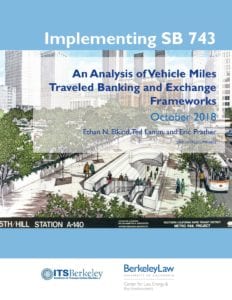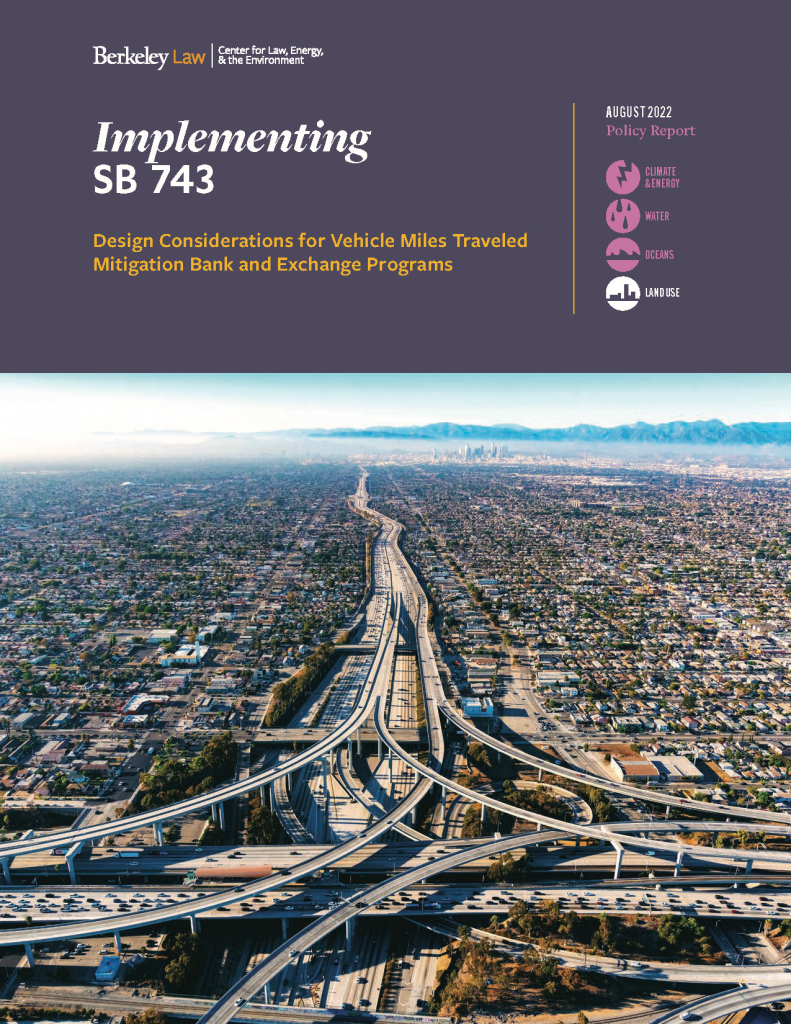When California state agencies and other local leaders build or approve projects that increase overall driving miles, state law requires them to mitigate those impacts. A new report from CLEE describes how these agencies can reduce vehicle miles traveled (VMT) by investing in offsite options like bike lanes, bus-only lanes, transit passes, and other measures that can effectively and efficiently reduce a corresponding amount of VMT.
Under the California Environmental Quality Act (CEQA), government agencies and developers are required to mitigate (where feasible) the significant environmental impacts of new projects subject to discretionary approval, including impacts to transportation.
Senate Bill 743, originally enacted in 2013, called for a new transportation impact measure that promotes greenhouse gas (GHG) emission reduction and multimodal transportation. In 2018 state leaders updated the CEQA guidelines to recommend VMT as the preferred impact measurement. VMT focuses on total vehicle trip-miles generated by a new project regardless of where they occur or how much traffic they cause.
Mitigating VMT impacts of new projects has the potential to shift California’s development patterns in a more sustainable, transit-oriented direction. It also creates the opportunity—and potentially the need—to conduct mitigation at locations other than the development site when onsite mitigation is not possible or practical. Such offsite mitigation can address the regional and statewide nature of VMT impacts in the most efficient and cost-effective locations, particularly when mitigation might prove difficult at the site of a suburban or exurban development.
If properly conducted, offsite mitigation could maximize flexible and locally appropriate transit, active transportation, and density investments. But to carry it out, state and local government leaders will need new frameworks to track mitigation obligations, plan investments, and facilitate transactions. CLEE and others have previously proposed “bank” and “exchange” programs to manage these capacities.
CLEE’s new report, Implementing SB 743: Design Considerations for Vehicle Miles Traveled Bank and Exchange Programs advances these proposals with a set of strategies for state agencies like Caltrans (the state agency most likely to be responsible for VMT-inducing projects) and local governments to develop bank and exchange programs that build on their existing environmental mitigation efforts. In addition to analyzing the legal and programmatic setting for VMT mitigation banks and exchanges, the report offers a set of recommendations for policymakers including:
- A state-level program for state agencies to manage mitigation and select locally appropriate investments, likely based on collaboration between Caltrans and other state transportation and land use agencies
- Regional-level programs for local and regional agencies to manage mitigation flexibly and efficiently within appropriate geographic limitations—likely managed by Metropolitan Planning Organizations or Regional Transportation Planning Agencies, but potentially run by large cities or counties in some cases
- Frameworks for analyzing the “additionality” of VMT mitigation investments to ensure that bank and exchange program funds support VMT reductions beyond those that would have occurred anyway
- Strategies for defining equity in the context of VMT mitigation and integrating equity into the decision-making of a bank or exchange program
Cities and counties around the state, from San José to San Diego, are in the process of developing their own approaches that could become, or could integrate into, VMT banks and exchanges. Caltrans and local government leaders will require significant time and resources to develop programs that fit the nature of the VMT-inducing projects they oversee and the needs and priorities of the areas they represent—and many questions remain, from prioritizing different mitigation investments to ensuring those investments are made in an equitable fashion. The strategies outlined in the report should help inform these decisions and advance the VMT reduction efforts initiated by the legislature nearly a decade ago.
This post was originally co-authored by Ted Lamm and Katie Segal on Legal Planet.
 California law now requires developers of new projects, like apartment buildings, offices, and roads, to reduce the amount of overall driving miles the projects generate. Senate Bill 743 (Steinberg, 2013) authorized this change in the method of analyzing transportation impacts under the California Environmental Quality Act (CEQA), from auto delay to vehicle miles traveled (VMT).
California law now requires developers of new projects, like apartment buildings, offices, and roads, to reduce the amount of overall driving miles the projects generate. Senate Bill 743 (Steinberg, 2013) authorized this change in the method of analyzing transportation impacts under the California Environmental Quality Act (CEQA), from auto delay to vehicle miles traveled (VMT).
In response to SB 743, some state and local leaders are seeking to create special “banks” or “exchanges” to allow developers to fund off-site projects that reduce VMT, such as new bike lanes, transit, and busways. These options could be useful when the developers lack sufficient on-site mitigation options.
A new report from Berkeley Law’s Center for Law, Energy and the Environment (CLEE), Implementing SB 743, provides a comprehensive review of key legal and policy considerations for local and regional agencies tasked with crafting these innovative mechanisms, including:
- Legal requirements under CEQA and Constitutional case law;
- Criteria for mitigation project selection and prioritization;
- Methods to verify VMT mitigation and “additionality”; and
- Measures to ensure equitable distribution of projects.
The report recommends that decision makers launching new VMT banks and exchanges consider including:
- Measures to verify the legitimacy of claimed VMT reductions, as well as their “additionality”;
- Prioritization of individual mitigation projects, in order to ensure that reductions are achieved as quickly and efficiently;
- Rigorous backstops to ensure that disadvantaged communities are not negatively impacted by—and ideally can benefit from—the ability of developers to move mitigation off-site; and
- Demonstration of both a reasonable substantive relationship and financial proportionality between the proposed development and the fee or condition placed on it.
Ultimately, SB 743 implementation will require a range of approaches from jurisdictions of varying sizes, densities, and development patterns throughout California. Local, regional, or even statewide mechanisms may evolve as mitigation programs mature and potential efficiencies are identified. Implementing SB 743 offers a guidebook to agencies and developers navigating the law’s new approach.
For more information, join CLEE’s webinar on Tuesday, October 30th from 10-11am with Governor’s Office of Planning and Research senior planner Chris Ganson and report co-author Ted Lamm and me. You can register for the free webinar today.



